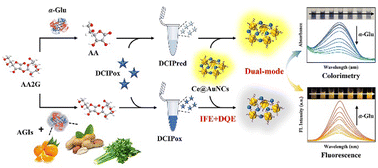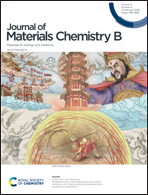Fluorometric and colorimetric dual-mode sensing of α-glucosidase based on aggregation-induced emission enhancement of AuNCs†
Abstract
Herein, a fluorometric and colorimetric dual-mode assay platform used for α-glucosidase (α-Glu) activity sensing based on aggregation-induced emission enhancement (AIEE) of AuNCs was developed for the first time. The quantum yield (QY) and fluorescence lifetime of AuNCs were successfully ameliorated by Ce3+-triggered AIEE (Ce@AuNCs). Subsequently, on the basis of the inner filter effect (IFE) and dynamic quenching effect (DQE) between 2,6-dichlorophenolindophenol (DCIP) and Ce@AuNCs as well as the reduction of DCIP by ascorbic acid (AA) generated from α-Glu-catalyzed hydrolysis of L-ascorbic acid-2-O-α-D-glucopyranosyl (AA2G), the marriage of fluorometric and colorimetric modes applied for α-Glu activity monitoring was achieved. Besides, the feasibility of this dual-mode sensing system was confirmed by the assays versus potential interfering substances and in real samples. In particular, this system was further applied to evaluate natural α-Glu inhibitors (AGIs) including luteolin, apigenin, and hesperidin. Overall, the multi-mode optical sensor newly designed here has the potential for the accurate discovery of natural anti-diabetes drugs and the therapy of diabetes.



 Please wait while we load your content...
Please wait while we load your content...